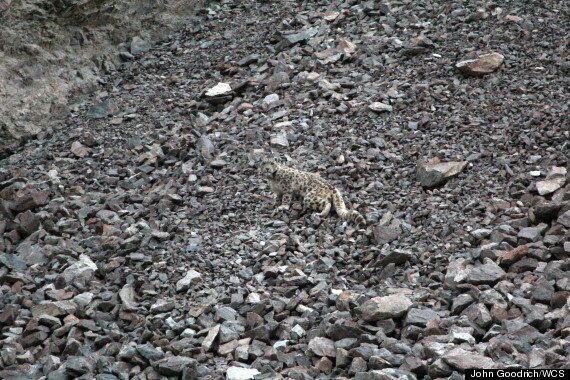Two snow leopards have been captured, fitted with satellite collars and released for the first time in Afghanistan – and one of them was tracked venturing 95 miles away.
The leopards were captured on 27 May and 8 June by a team of Wildlife Conservation Society (WCS) researchers and Afghan veterinarians.
Each cat was weighed, measured, fitted with a Vectronix satellite collar, and DNA samples were taken.

Rock on: This was the first snow leopard of the pair to be collared
After DNA samples, the healthy snow leopards were released and headed up the Hindu Kush Mountains in good condition.
The big cats will be tracked by WCS to better understand their behaviour and range.
So far, the first snow leopard, Pahlawan, has travelled more than 77 miles (125 kilometres), while the second cat, Khani Wakhai, has travelled more than 95 miles (153 kilometres).
The veterinary team, including WCS's Dr Stephane Ostrowski and two Afghan colleagues Dr Ali Madad and Dr Hafizullah Noori, conducted the tranquilising process at the capture sites along with Nat Geo Wild's Boone Smith, an expert tracker who travelled to Afghanistan for the project with the Nat Geo Wild film crew.
An adult snow leopard stands about two feet at the shoulder and weighs between 60 and 120 pounds.
The snow leopard is an alpine rock-climbing specialist with large paws that are ideally adapted to both rocky terrain and deep snow drifts and thick fur to stay warm.
David Lawson, WCS Afghanistan Country Director, said: "These captures are sensational. They are also a real tribute to the knowledge of the local community rangers and the success of our recent camera trapping efforts, which enabled the team to select spots that were known to be frequented by snow leopards."
The range of the snow leopard includes about 1.2 million square miles across 12 nations in Asia from Russia to Nepal.
It is the apex predator and a flagship species for one of the last great wilderness regions on earth – the spectacular mountain ranges of Asia, including the Himalaya, Karakoram, Hindu Kush, Pamir, Tien Shan, and Altai ranges.
The entire process was documented by a Nat Geo Wild television crew for a world premiere special, Snow Leopards of Afghanistan, premiering this December on Nat Geo Wild during the third annual Big Cat Week, an extension of the Cause An Uproar campaign, dedicated to saving the world's big cats.
Despite survival skills such as spectacular leaping ability and colouring that camouflages them to near invisibility on the rocky alpine slopes of their native habitat, the snow leopard faces threats that are bringing this species closer to extinction.
Snow leopards have been categorised as an Endangered Species on the International Union for Conservation of Nature's Red List since 1972, and the species is listed as endangered by almost all range countries.
Despite these listings, snow leopard populations are still thought to be dwindling across most of their range, with only 3,000 to 7,500 individuals thought to exist.
Their numbers are so few and their behaviour is so elusive that camera traps are the only reliable way of capturing these big cats on film.
There are five major threats facing snow leopards in the wild:
- poaching, especially for the skins but also for the traditional medicinal trade
- loss of natural wild prey - mostly wild sheep and goats, but also marmots and smaller prey
- retaliatory killing by shepherds and villagers when snow leopards switch to livestock as the only available alternative food source
- general disturbance of habitat as people increasingly move into snow leopard ranges
- lack of awareness by local communities and governments of the rapid disappearance of snow leopards and the need for improved enforcement both in and outside protected areas
Peter Zahler, WCS Deputy Director of Asia Programs, said: "The information garnered from the tagging will assist researchers as they learn more about the range, behaviour, movements, and habitat used by snow leopards.
"This information in turn will help us in our partnership with the Afghan government and local communities to design protected areas and management strategies to optimise the conservation of this big cat."
Ghani Ghuriani, Afghanistan deputy minister for Agriculture Affairs in the Ministry of Agriculture, said: "The snow leopard is an iconic species for our country. Its continued presence in Afghanistan shows that our efforts at improving natural resource management – from rangeland practices to wildlife protection – are succeeding."